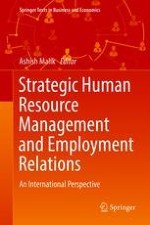2018 | OriginalPaper | Buchkapitel
Special Topics in SHRM & ER
verfasst von : Ashish Malik
Erschienen in: Strategic Human Resource Management and Employment Relations
Verlag: Springer Singapore
Aktivieren Sie unsere intelligente Suche, um passende Fachinhalte oder Patente zu finden.
Wählen Sie Textabschnitte aus um mit Künstlicher Intelligenz passenden Patente zu finden. powered by
Markieren Sie Textabschnitte, um KI-gestützt weitere passende Inhalte zu finden. powered by
Abstract
-
Define the terms ambidexterity and public service motivation
-
Analyse the relationship between HRM practices, ambidexterity and innovation
-
Analyse the impact of employee well-being on the HRM-performance link
-
Identify the emerging trends in Green HRM
-
Discuss the key approaches in managing people in times of a crisis
